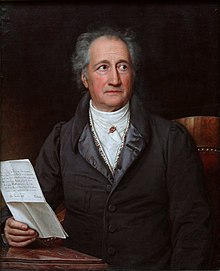Isaac Newton - Wikipedia, the free encyclopedia
Gravitational constant - Wikipedia, the free encyclopedia
gravitational constant = 6.67300 × 10-11 m3 kg-1 s-2 |
| Johann Wolfgang von Goethe | |
|---|---|
 | |
| Born | 28 August 1749 Free Imperial City of Frankfurt, Holy Roman Empire |
| Died | 22 March 1832 (aged 82) Weimar, Grand Duchy of Saxe-Weimar-Eisenach, German Confederation |
| Occupation | Poet, Novelist, Playwright, Natural Philosopher, Diplomat, Civil servant |
| Nationality | German |
| Literary movement | Sturm und Drang; Weimar Classicism |
Goethe's Faust
DNA is a double helix formed by base pairs attached to a sugar-phosphate backbone.
Nucleic acid double helix - Wikipedia, the free encyclopedia
In molecular biology, the term double helix refers to the structure formed by double-stranded molecules of nucleic acids such as DNA and RNA. The double ...

Gravitational Waves
The gravitational force is extremely weak compared with other fundamental forces. For example, the gravitational force between an electron and proton one meter apart is approximately 10−67 newtons, while the electromagnetic force between the same two particles is approximately 10−28 newtons.
Gravity ---> mental forces --> thus the geography land G --> German literature expressions of bio-gravity agent G = Goethe
What are the 4 nucleotides for DNA
A = Adenine --> Ade + nine--> Ade + 9 data bits (8 data bits + 1 error checking parity bit...for accurate thoughts)
G = Guanine --> Gua + 9 --> Gua + (8 data bits + 1 error checking bit for BALONEY social science stories)
C = Cytosine
T = Thymine --> T hy --> Time highway and the year 2000 biological clock failure to upgrade
Genetic code
G --> Gravity code -->vertical vector force on EARTH

The genetic code is the set of rules by which information encoded within genetic material (DNA or mRNA sequences) is translated into proteins (amino acid sequences) by living cells. Biological decoding is accomplished by the ribosome, which links amino acids in an order specified by mRNA, using transfer RNA (tRNA) molecules to carry amino acids and to read the mRNA three nucleotides at a time. The genetic code is highly similar among all organisms, and can be expressed in a simple table with 64 entries.
The code defines how sequences of these nucleotide triplets, called codons, specify which amino acid will be added next during protein synthesis. With some exceptions,[1] a three-nucleotide codon in a nucleic acid sequence specifies a single amino acid. Because the vast majority of genes are encoded with exactly the same code (see the RNA codon table), this particular code is often referred to as the canonical or standard genetic code, or simply the genetic code, though in fact some variant codes have evolved. For example, protein synthesis in human mitochondria relies on a genetic code that differs from the standard genetic code.
The First Part of the Tragedy
Sequence reading frame
A codon is defined by the initial nucleotide from which translation starts. For example, the string GGGAAACCC, if read from the first position, contains the codons GGG, AAA, and CCC;
Sequence reading frame
Each codon consists of three nucleotides, usually representing a single amino acid.
The nucleotides are abbreviated with the letters A, U, G
Effect of mutations
Missense mutation
Nonsense mutation
Mutations that disrupt the reading frame sequence by indels (insertions or deletions) of a non-multiple of 3 nucleotide bases are known as frameshift mutations
Goethe and Mephistopheles, a Devil
The First Part of the Tragedy
The principal characters of Faust Part One include:
- Heinrich Faust, a scholar, sometimes said to be based on the real life of Johann Georg Faust, or on Jacob Bidermann's dramatized account of the Legend of the Doctor of Paris, Cenodoxus
- Mephistopheles, a Devil
- Gretchen, Faust's love (short for Margaret; Goethe uses both forms)
- Marthe, Gretchen's neighbour
- Valentin, Gretchen's brother
- Wagner, Faust's famulus
Gretchen --> G + ret + c ---> Guanine bio-computer RETURN codes

